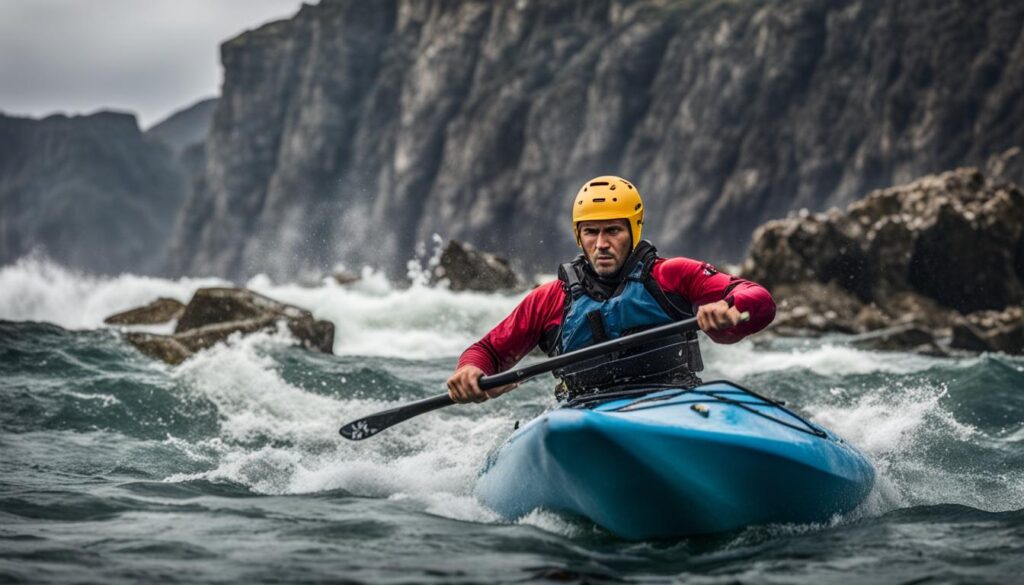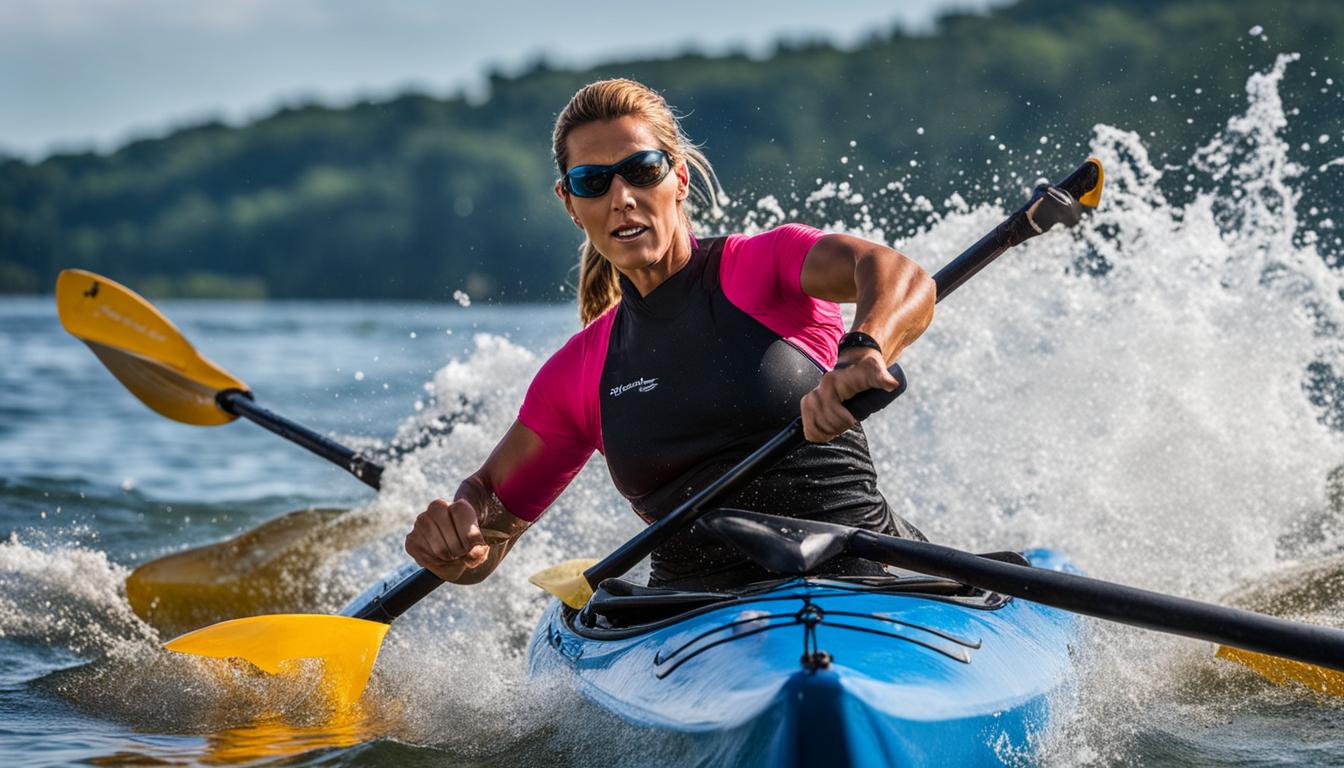Improve your kayaking fitness and enhance your paddling endurance with these effective cardiovascular workouts. Whether you’re a beginner or an experienced kayaker, incorporating cardio training into your routine can significantly enhance your performance on the water. In this article, we’ll provide you with tips, techniques, and workout plans specifically designed to boost your kayaking endurance.
Key Takeaways:
- Cardiovascular workouts are essential for improving kayaking endurance
- Both muscular strength and endurance play a crucial role in kayaking performance
- Follow a structured training program to build specific kayaking strength and endurance
- Incorporate targeted exercises to improve overall paddling strength
- Include flatwater sessions to enhance kayaking endurance
Elevate your kayaking performance with these cardio techniques and conquer new challenges on the water.
Understanding Muscular Strength and Endurance
Before diving into the training exercises, it’s important to understand the difference between muscular strength and muscular endurance. Muscular strength refers to the amount of resistance your muscles can handle in a single contraction, which is crucial for maintaining proper body mechanics while kayaking. On the other hand, muscular endurance refers to the ability of your muscles to work continuously for a long period of time without tiring. Both aspects are essential for kayaking and can be improved through targeted exercises.
When it comes to kayaking, having strong muscles helps you maintain stability and control, especially when paddling against strong currents or waves. It also allows you to perform powerful strokes and maneuvers effectively. On the other hand, muscular endurance is important for prolonged paddling sessions, such as long-distance kayaking or multi-day trips.
Strength Training Exercises
To improve muscular strength for kayaking, focus on exercises that target the key muscle groups used during paddling. These include the back, shoulders, arms, core, and legs. Here are some effective strength training exercises:
- Kettlebell swings: This exercise strengthens the muscles in your back, hips, and legs, providing power for your strokes.
- Overhead press: Helps build shoulder and arm strength, improving your ability to perform powerful paddle strokes.
- Cleans: Works multiple muscle groups, including the back, legs, and core, to enhance overall strength and coordination.
- Goblet squats: Targets the lower body, particularly the quadriceps, glutes, and hamstrings, for improved stability and power in your strokes.
Remember to start with lighter weights and gradually increase the load as you progress. Proper form and technique are crucial to prevent injuries. Consult with a certified personal trainer for guidance and individualized workout plans.
Endurance Training Exercises
To enhance muscular endurance for kayaking, focus on exercises that target the same muscle groups used during prolonged paddling sessions. These exercises help improve the efficiency and stamina of your muscles. Here are some effective endurance training exercises:
- Rowing machine: Mimics the paddling motion and engages the back, arms, shoulders, and core. Start with shorter sessions and gradually increase the duration.
- Cycling: Builds lower body endurance and cardiovascular fitness, which translates to improved stamina during kayaking.
- Plank variations: Strengthen the core muscles, enhancing stability and reducing fatigue during long paddling sessions.
- Swimming: A whole-body workout that improves both strength and endurance, while also providing a low-impact alternative for active recovery.
Incorporate these exercises into your training routine and gradually increase the duration and intensity as your muscular endurance improves. Remember to listen to your body and rest when needed to prevent overtraining and injuries.
Kayak Training Program Outline
To build muscular strength and endurance specific to kayaking, it’s important to follow a structured training program. The program should be implemented during the off-season and can last for about 8 weeks. The frequency of training should be three times a week on land and 1-2 times a week on water. Each session should consist of 3-5 sets of 6-10 reps for strength exercises and 3-5 sets of 12-15 reps for endurance exercises.
When designing your kayak training program, it’s crucial to incorporate paddling-specific exercises that target the muscles used in kayaking. These exercises help improve overall paddling performance and prepare your body for the demands of the water. Some key exercises to include in your program are:
- Kettlebell swings: This exercise targets the core, shoulders, and back muscles, which are essential for generating power in your strokes.
- Overhead press: A great exercise for building shoulder strength and stability, as well as improving your ability to paddle with control.
- Cleans: This full-body exercise works multiple muscles simultaneously, helping to improve your overall strength and power.
- Goblet squats: Squats are excellent for building leg strength, which is crucial for stability and efficient paddling.
- Pull-ups: Strengthening your upper body, especially your back and arms, is essential for maintaining proper posture and generating power in your strokes.
- Cable rows: This exercise targets the muscles in your back and arms, helping to improve endurance and pulling strength.
- Push-ups: Push-ups help build upper body strength, particularly in the chest, shoulders, and triceps, which are essential for paddling stability and power.
Incorporating these exercises into your training program will help you develop the strength and endurance necessary to excel in kayaking. Remember to start with lighter weights or lower intensity and gradually increase as your fitness improves. It’s also important to listen to your body and rest when needed to prevent overtraining and avoid injuries.
| Exercise | Sets | Reps |
|---|---|---|
| Kettlebell swings | 3-5 | 6-10 |
| Overhead press | 3-5 | 6-10 |
| Cleans | 3-5 | 6-10 |
| Goblet squats | 3-5 | 6-10 |
| Pull-ups | 3-5 | 6-10 |
| Cable rows | 3-5 | 12-15 |
| Push-ups | 3-5 | 12-15 |
Kayaking Strength Exercises: Boost Your Paddling Power
When it comes to building kayaking strength, incorporating specific exercises into your training routine is essential. These exercises target the muscles used in kayaking and help improve overall paddling power. From upper body strength to core stability, here are some basic exercises that can take your kayaking performance to the next level.
Upper Body Exercises
Strong arms, shoulders, and back are crucial for maintaining proper paddling technique and generating power on the water. Incorporate the following exercises into your routine:
- Push-ups: This classic exercise targets the chest, shoulders, and triceps. Start with a modified push-up position if needed, and gradually progress to a full push-up.
- Overhead press: Use dumbbells or a barbell to strengthen your shoulders. Lift the weights above your head, maintaining proper form and controlled movements.
- Pull-ups: Install a pull-up bar and challenge yourself with this highly effective exercise that targets the upper back, shoulders, and arms.
Core and Lower Body Exercises
A strong core and lower body stability are essential for maintaining balance and generating power while kayaking. Try these exercises:
- Goblet squats: Hold a kettlebell or a dumbbell close to your chest and perform deep squats. This exercise targets the quadriceps, hamstrings, and glutes.
- Cable rows: Utilize a cable machine to strengthen your back muscles. Keep your core engaged and pull the handles towards your body, squeezing your shoulder blades together.
Incorporating these basic exercises into your kayaking training program can help you build the necessary strength and power to conquer any water challenge. Remember to start with lighter weights and gradually increase the intensity as your muscles adapt. Consistency and proper form are key to achieving optimal results.

Table: Kayaking Strength Exercise Guide
| Exercise | Targeted Muscles | Instructions |
|---|---|---|
| Push-ups | Chest, shoulders, triceps | Start in a plank position, lower your body, and push back up |
| Overhead press | Shoulders, upper arms | Hold dumbbells or a barbell at shoulder height, press them overhead |
| Pull-ups | Back, shoulders, arms | Hang from a bar with an overhand grip, pull your body up until your chin is above the bar |
| Goblet squats | Quadriceps, hamstrings, glutes | Hold a kettlebell close to your chest, squat down while keeping your back straight |
| Cable rows | Back, shoulders, biceps | Attach a handle to a cable machine, sit upright, pull the handle towards your body, and squeeze your shoulder blades together |
Kayaking Endurance Exercises: Elevate Your Stamina on the Water
Building kayaking endurance is essential for tackling long-distance paddling and enjoying extended adventures on the water. By incorporating targeted exercises into your training routine, you can improve your cardiovascular stamina and endurance, allowing you to paddle for longer periods with ease.
To enhance your kayaking endurance, one effective strategy is to incorporate flatwater sessions into your training routine. These sessions provide a controlled environment without the challenges of unpredictable currents and waves. Start with moderate-paced paddling for 20 minutes or two 10-minute intervals during the first four weeks. This allows your body to adapt gradually and build a solid foundation of endurance.
In the following four weeks, progress to more intense intervals. Incorporate five 3-minute bursts of hard paddling, alternating with 1.5-minute recovery intervals. This high-intensity interval training (HIIT) approach will push your cardiovascular system, further enhancing your endurance for longer kayaking excursions.

Sample Flatwater Training Routine
| Week | Training Time | Intensity |
|---|---|---|
| 1-4 | Moderate-paced paddling | 20 minutes or two 10-minute intervals |
| 5-8 | High-intensity intervals | Five 3-minute bursts of hard paddling with 1.5-minute recovery intervals |
Remember to warm up properly before each session, gradually increasing the intensity. Incorporate stretching exercises to improve flexibility and reduce the risk of injury. It’s also important to listen to your body and adjust the intensity and duration of your sessions accordingly. If you feel fatigued or experience any discomfort, take a break and allow yourself time to recover.
By incorporating these kayaking endurance exercises into your training program, you’ll be well-prepared to conquer longer distances and enjoy extended paddling adventures. Enhance your cardiovascular stamina and elevate your kayaking performance on the water!
Year-Long Kayak Training Program
To maintain your kayaking fitness throughout the year, it’s important to follow a comprehensive training program. This program can be divided into different phases based on the time of the year, allowing you to optimize your training for different aspects of kayaking performance. By following this year-long program, you can enhance your skills, build strength and endurance, and improve your overall paddling abilities.
Phase 1: Paddling-Specific Muscle Strength and Endurance (January to February)
In the initial phase of the program, focus on building paddling-specific muscle strength and endurance. This includes exercises that target the muscles used in kayaking, such as kettlebell swings, overhead presses, cleans, goblet squats, pull-ups, cable rows, and push-ups. Aim to perform these exercises three times a week on land and 1-2 times a week on water.
Phase 2: Paddling-Specific Endurance (March to April)
In the second phase, shift your focus to paddling-specific endurance while maintaining strength and power. Incorporate flatwater sessions into your training routine and gradually increase the intensity and duration of your paddling. Start with moderate-paced paddling for 20 minutes or two 10-minute intervals in the first 4 weeks, then progress to five 3-minute bursts of hard paddling with 1.5-minute recovery intervals for the following 4 weeks.
Phase 3: Competition Season (May to August)
During the competition season, which typically spans from May to August, prioritize improving your technique and performance. This includes refining your paddling stroke, practicing race-specific strategies and maneuvers, and participating in competitive events. Additionally, continue to maintain your overall fitness and strength with regular training sessions.
Phase 4: General Endurance and Strength Training (September to October)
In the months of September and October, shift your focus towards general endurance and strength training. Incorporate cross-training activities to enhance stability, flexibility, and overall fitness. This may include activities like running, swimming, yoga, or weightlifting. The goal is to maintain your physical abilities while allowing your body to recover from the intense competition season.
Phase 5: Cross-Training and Overall Fitness (November to December)
In the final phase of the year-long program, focus on cross-training activities that promote overall fitness. Engage in activities that complement kayaking, such as cycling, hiking, or group fitness classes. These activities will help you maintain your cardiovascular fitness, build strength in different muscle groups, and keep you active during the off-season.
By following this year-long training program, you can effectively structure your kayaking training to optimize performance throughout the year. Remember to adapt the program to your individual needs and consult with professionals if needed to ensure you’re training safely and efficiently. Elevate your kayaking abilities and enjoy the rewards of your hard work on the water!
Important Considerations and Safety Measures
When embarking on a kayak training program, it is crucial to prioritize safety measures and take necessary precautions to prevent injuries and ensure a smooth training journey. Here are some important considerations:
1. Build a Strong Foundation
Before diving into advanced exercises, it is essential to establish a good base of muscular strength and endurance. This will help prevent overexertion and reduce the risk of injuries. Start with foundational exercises that target major muscle groups and gradually progress to more challenging movements.
2. Perfect Your Form
Proper form is key to preventing injuries and maximizing the effectiveness of your workouts. Take the time to learn the correct technique for each exercise and focus on maintaining proper body alignment throughout your training sessions. If you are unsure about proper form, consult with a certified personal trainer who can guide you and provide feedback on your technique.
3. Listen to Your Body
Pay attention to how your body feels during and after each workout. If you experience pain, discomfort, or excessive fatigue, it is important to listen to your body’s signals and adjust the intensity and frequency of your training accordingly. Pushing through pain can lead to further injury, so always prioritize your safety and well-being.
“Your safety should always be your top priority. Take the necessary precautions, listen to your body, and consult with professionals if needed.”
In conclusion, incorporating cardio workouts into your kayaking training can be highly beneficial for improving endurance and overall performance. However, ensuring your safety throughout the training process is of utmost importance. By building a strong foundation, perfecting your form, and listening to your body, you can minimize the risk of injuries and make the most of your training sessions. Remember, safety first always!
Conclusion
By incorporating cardiovascular workouts into your kayaking training, you can enhance your endurance and overall performance on the water. Following a structured training program that includes both strength and endurance exercises is key to improving your kayaking fitness. Remember to tailor the program to your individual needs and consult with professionals if needed.
It is important to consider safety measures and precautions before starting any training program. Build a good base of muscular strength and endurance before engaging in advanced exercises. Start slowly, focus on perfecting form, and listen to your body to avoid injuries. Consulting with a certified personal trainer or healthcare professional is always a good idea before embarking on a new fitness program.
Elevate your kayaking performance by implementing these cardio techniques. With dedication and consistency, you can conquer new challenges on the water and enjoy longer, more rewarding paddling experiences. So, get out there and start improving your kayaking endurance today!
FAQ
What is the difference between muscular strength and muscular endurance?
Muscular strength refers to the amount of resistance your muscles can handle in a single contraction, while muscular endurance refers to the ability of your muscles to work continuously for a long period of time without tiring.
How often should I incorporate cardiovascular workouts into my kayaking training?
It is recommended to incorporate cardiovascular workouts three times a week on land and 1-2 times a week on water.
What exercises can I do to improve kayaking strength?
Some key exercises for kayaking strength include kettlebell swings, overhead press, cleans, goblet squats, pull-ups, cable rows, and push-ups.
How can I improve kayaking endurance?
To improve kayaking endurance, incorporate flatwater sessions into your training routine. Start with moderate-paced paddling and gradually increase intensity.
What should my year-long kayak training program include?
Your year-long kayak training program should include phases that focus on paddling-specific muscle strength and endurance, endurance while maintaining strength and power, technique and performance improvement, general endurance and strength training, and overall fitness and strength-building activities.
What precautions should I take before starting a training program for kayaking?
It is important to have a good base of muscular strength and endurance before engaging in advanced exercises. Start slowly, focus on form, and consult with a certified personal trainer or healthcare professional if needed.
How can cardiovascular workouts improve my kayaking performance?
By incorporating cardio workouts into your kayaking training, you can improve your endurance and overall performance on the water.
Can I tailor the training program to my individual needs?
Yes, it is recommended to tailor the training program to your individual needs. Consulting with professionals can also help determine the best approach for you.
How long should the training program last?
The training program can last for about 8 weeks, with different phases throughout the year to maintain and enhance your kayaking fitness.





